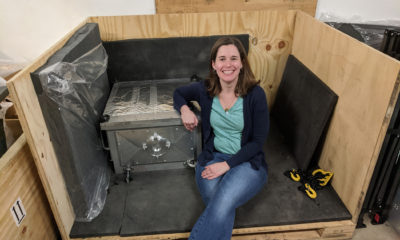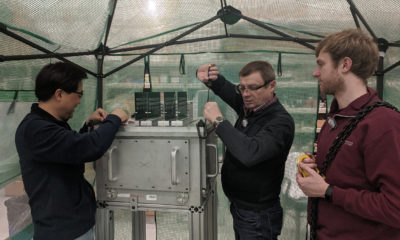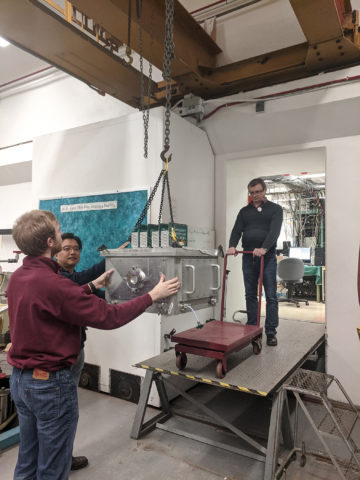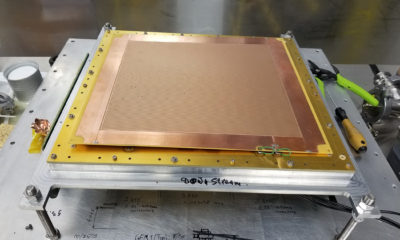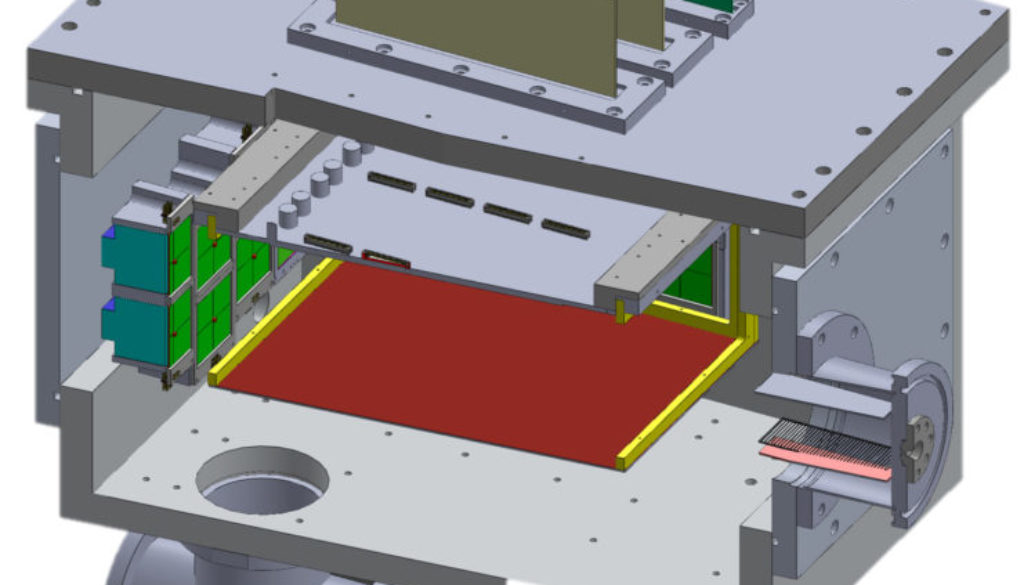 Dr. Grigory Rogachev
Dr. Grigory Rogachev
Carbon, known universally as the basic building block of life, is generally thought by scientists to have formed inside the cores of stars. Now, an experimental apparatus designed by scientists at Texas A&M University is playing a major, first-of-its-kind role in a collaboration to test whether or not the element could have been produced under additional alternate circumstances.
The device is called the
Texas Active Target, or TexAT — a type of particle detector known as an active-target time-projection chamber that was constructed at the
Texas A&M Cyclotron Institute. A research collaboration involving physicists from Texas A&M, Washington University in St. Louis and Ohio University are using TexAT in combination with powerful neutron beam lines at Ohio’s
John E. Edwards Accelerator Laboratory to see if carbon can be more efficiently produced if a sufficient flux of neutrons is also present in the carbon-producing regions in stars.
It’s described as “a novel experiment” by Cyclotron Institute member
Grigory Rogachev, professor and head of the
Texas A&M Department of Physics and Astronomy and an expert in low energy experimental nuclear physics and nuclear astrophysics. Time projection chambers like TexAT are typically used to produce three-dimensional renderings of the trajectories of rare isotope beams and the products of nuclear reactions induced by those beams. Rogachev, a principal investigator in the project whose research group spent six years designing and constructing TexAT, notes that using such a device to explore nuclear reactions with neutrons has never been done before.
 CENTAUR postdoctoral research associate Cody Parker, chilling beside TexAT as she waits to help unpack the detector at the John E. Edwards Accelerator Laboratory at Ohio University, where she earned her Ph.D. in 2016.
CENTAUR postdoctoral research associate Cody Parker, chilling beside TexAT as she waits to help unpack the detector at the John E. Edwards Accelerator Laboratory at Ohio University, where she earned her Ph.D. in 2016.
“The realization that TexAT can be used so efficiently with neutron beams was absolutely a revelation,” Rogachev said. “It turned out that it was much easier to work with neutron beams with our detector, even though it really wasn’t originally designed for that.”
The collaboration’s recent experiment is detailed in a March 19
Scientific American article. The joint effort was funded in part by the
Center for Excellence in Nuclear Training and University-based Research (CENTAUR), a multi-institutional effort led by Texas A&M that seeks to support collaborative research efforts in the area of low-energy nuclear science.
Carbon-12, the most common form of the element, can only exist when three helium-4 nuclei, called alpha particles, come together to form an excited state and release energy in a very specific way. This so-called “triple-alpha” process, believed to occur in stellar cores, also has a low success rate when it comes to creating carbon atoms. Carbon-12 is formed in its ground state only an estimated four out of every 10,000 times three helium-4 isotopes unite.
 Texas A&M Cyclotron Institute assistant research scientists (from left) Sunghoon “Tony” Ahn and Evgeniy Koshchiy make adjustments as Jack Bishop, a postdoctoral research associate in the Rogachev group, surveys the team’s progress.
Texas A&M Cyclotron Institute assistant research scientists (from left) Sunghoon “Tony” Ahn and Evgeniy Koshchiy make adjustments as Jack Bishop, a postdoctoral research associate in the Rogachev group, surveys the team’s progress.
A few years ago, researchers at the University of Notre Dame and Michigan State University (Mary Beard, Sam M. Austin and Richard Cyburt) proposed an idea that neutrons may play a role in carbon formation. They theorized that when the three alpha particles come together in certain stellar environments, a stray neutron is capable of displacing extra energy, resulting in an enhanced triple-alpha process by a factor of as much as 100.
Experimental verification of this idea is challenging, given that it requires measuring a scattering process involving four particles, one of which is a neutron. Washington University nuclear chemist and CENTAUR member
Lee Sobotka came up with an idea of how this can be done using time-projection chambers. Rogachev, Sobotka and their colleagues in Ohio decided to partner up to test this theory and began experimentation in March.
 (From left:) Jack Bishop and Sunghoon “Tony” Ahn steady TexAT as Evgeniy Koshchiy prepares to help them lower the detector safely onto the dolly.
(From left:) Jack Bishop and Sunghoon “Tony” Ahn steady TexAT as Evgeniy Koshchiy prepares to help them lower the detector safely onto the dolly.
Jack Bishop, a postdoctoral research associate in the Rogachev group who oversees the implementation of experimental techniques in TexAT, explains that because carbon-12 exists in its excited state for only a fraction of a second, it’s essentially impossible to measure the same process that occurs in stars. Instead, the team measured the probability of its
reverse reaction, or the inverse of the original triple-alpha process.
“Rather than study the astrophysical reaction itself, which would be very difficult, we can look at this time-reverse reaction,” Bishop said. “We can then correlate this to the astrophysical event.”
In order to do this, the researchers shoot a beam of high-energy neutrons into the carbon-dioxide-filled TexAT. When a neutron collides with a carbon-12 atom, the charged particles created during the nuclear interaction fly away and ionize the gas. This in turn creates electrons, which are guided by an electric field to an upper panel of the detector, where their spatial positions are recorded, giving the researchers a 3-D tracks of the alpha particles.
“We didn’t know what the probability was for this nuclear reaction to happen in a stellar environment, and now we do,” Rogachev said. “Our experiment is providing data and actual measurements for this theoretical process.”
 This panel within the TexAT detector records the spatial positions of the electrons as they scatter, giving the researchers a 3-D tracking of any resulting alpha particles created when the highly charged neutrons collide with a carbon-12 atom.
This panel within the TexAT detector records the spatial positions of the electrons as they scatter, giving the researchers a 3-D tracking of any resulting alpha particles created when the highly charged neutrons collide with a carbon-12 atom.
Approximately 5,000 neutrons per second were emitted into TexAT, with only about one in a million of them rendering a reverse triple-alpha process — roughly one occurrence every five minutes. A week’s worth of data was collected before the lab was forced to close due to the COVID-19 pandemic, but Rogachev says the experiment will resume once the restrictions are lifted.
The Ohio trip marked a homecoming of sorts for CENTAUR postdoctoral research associate Cody Parker, who completed her Ph.D. at Ohio University in 2016. Parker, whose expertise is in neutron detector development, coordinated with scientists at her alma mater’s accelerator facility to make sure that the neutron beam was well-optimized for the desired reaction in TexAT.
“I always find it interesting to see what you
can do with neutron-induced reactions, specifically because it’s just not something you can do every day,” Parker said. “It’s very important to realize that you can’t simply make a neutron beam; it’s very difficult to do. There are a lot of steps involved that maybe go unappreciated, and hopefully what we’ve been able to do with TexAT and Ohio University will change that.”
 Texas A&M’s TexAT team is all smiles as they prepare to return to College Station with a week’s worth of data following a successful trip to Ohio and the first run of the collaboration’s groundbreaking experiment.
Texas A&M’s TexAT team is all smiles as they prepare to return to College Station with a week’s worth of data following a successful trip to Ohio and the first run of the collaboration’s groundbreaking experiment.
Key personnel involved in the project in addition to Bishop and Parker include Cyclotron Institute assistant research scientists Evgeniy Koshchiy and Sunghoon “Tony” Ahn. Rogachev credits the four with handling the majority of the experimental setup, measurements, hardware and software development, and results analysis — an undertaking he says likely wouldn’t have happened without CENTAUR.
“This experiment is a perfect example of the positive effect of close collaboration between institutions, which was made possible by CENTAUR,” Rogachev said. “CENTAUR provided both the platform and funds and also put together people from different institutions in a way that facilitated this work tremendously.”
Plans are already in place for TexAT to be the focal point of many more experiments to come, both at Texas A&M and at other institutions, once its work in Ohio is finished. Rogachev also notes that the device will undergo a substantial upgrade in the near future.
“Hopefully within a year or two, we’ll have an even better detector with better resolution and better tracking capabilities,” he said.
Nearly two months removed from that fateful trek to the Edwards Accelerator Lab, Rogachev says he remains in awe of the groundbreaking turn of events set in motion by curiosity, common interests and collegiality.
“Combining an alternate theory, an idea of how it could be tested experimentally and a unique experimental apparatus originally conceived for a different kind of measurement with an excellent neutron beam that the Ohio U facility can provide gave us a perfect mix that resulted in a very interesting and in many ways trailblazing experiment,” Rogachev said. “Never before has an active target setup been used with neutron beams. It is a milestone that demonstrates the advantages of the technique, and I am sure it will be copied by many labs in the future.”
To learn more about Rogachev and his research group, visit
https://physics.tamu.edu/directory/grigory-rogachev/.
See additional photographs of TexAT and the Texas A&M team’s trip to Ohio, courtesy of Jack Bishop.
# # # # # # # # # #
About the Cyclotron Institute: Dedicated in 1967, the Cyclotron Institute serves as the core of Texas A&M University’s accelerator-based nuclear science and technology program. Affiliated faculty members from the Department of Chemistry and the Department of Physics and Astronomy conduct nuclear physics- and chemistry-based research and radiation testing within a broad-based, globally recognized interdisciplinary platform supported by the United States Department of Energy (DOE) in conjunction with the State of Texas and the Welch Foundation. The facility is one of five DOE-designated Centers of Excellence and is home to one of only five K500 or larger superconducting cyclotrons worldwide. To learn more, visit
https://cyclotron.tamu.edu/.
About CENTAUR: The Center for Excellence in Nuclear Training And University-based Research (CENTAUR) is a multi-institutional effort supported by a five-year, $10 million Stewardship Science Academic Alliances (SSAA) grant from the Department of Energy’s National Nuclear Security Administration (DOE/NNSA). CENTAUR pursues basic research in low-energy nuclear science through experimental, theoretical and technical programs using accelerators at Texas A&M’s Cyclotron Institute and Florida State University’s John D. Fox Superconducting Linear Accelerator Laboratory as well as facilities at the other partner institutions, which include Texas A&M University, Florida State University, Washington University in St. Louis, the University of Washington, Louisiana State University and the University of Notre Dame. To learn more, visit
https://centaur.tamu.edu/.
About Research at Texas A&M University: As one of the world’s leading research institutions, Texas A&M is at the forefront in making significant contributions to scholarship and discovery, including that of science and technology. Research conducted at Texas A&M represented annual expenditures of more than $952 million in fiscal year 2019. Texas A&M ranked in the top 20 of the National Science Foundation’s most recent Higher Education Research and Development survey (2018), based on expenditures of more than $922 million in fiscal year 2018. Texas A&M’s research creates new knowledge that provides basic, fundamental and applied contributions resulting, in many cases, in economic benefits to the state, nation and world. To learn more, visit
Research@Texas A&M.
-aTm-
Contact: Chris Jarvis, (979) 845-7246 or
cjarvis@science.tamu.edu, or Dr. Grigory Rogachev, (979) 458-0349 or
rogachev@ tamu.edu
The post
Texas A&M-Led Experiment Uses Novel Particle Detector to Track Alternate Theory Behind Carbon Creation in Stars appeared first on
Texas A&M College of Science.

